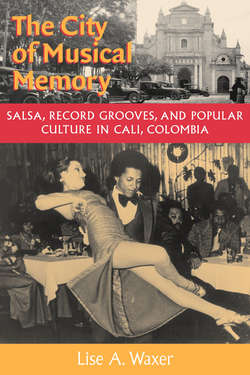Читать книгу The City of Musical Memory - Lise A. Waxer - Страница 14
Subjectivity and Popular Identity in Cali
ОглавлениеThere is a striking paradox in Cali’s adoption of salsa: at the same time Caleños have become cosmopolitan, they have remained extremely localist, participating only secondarily in regional and national cultures, and using their participation in transnational salsa and música antillana to underscore their sense of local difference from the national. What does this suggest for our understanding of Caleño subjectivity, in relation to concentric spheres of popular culture? Within the Colombian context, Caleños form a very particular sort of subject, born out of the historical conditions that have positioned Cali both within and against the national grain. As I discuss in greater detail in chapter 1, the insular hacienda economy established in southwest Colombia during colonial times fostered weak economic and political ties between Cali and other regions. This contrasted with the Atlantic Coast region—oriented outward to Caribbean commerce and culture—and the wealthy, politically powerful interior regions of Antioquia and the capital of Bogotá, which had ties to Spain. By the twentieth century, Cali’s economic insularity had been radically transformed by shifts in Colombian export markets in coffee and sugar, but this change was not accompanied by a marked entry into national cultural and political life. Rather, Caleños continued to define and extend their insularity by adopting a musical style that stood outside of national genres and hence served to reposition Caleño difference from the national arena. The influence of salsa and its Afro-Caribbean roots served as the basis for the formation of an alternative cosmopolitical identity that expressed the local sense of disparity from the rest of the nation, without forcing them to sacrifice engagement with larger transnational processes.
My concern with social identities, spaces, and experiences in Caleño popular culture has not always provided clear answers to the question of how subjectivity is constructed in Cali. Where do we draw the line between context-specific subjective experiences, tied to certain moments, places, and people, and the larger “popular identity” to which these experiences accrue?14 Identity politics, mooring on the “interrelated problems of self-recognition and recognition by others,” have formed a crucial body of scholarship in recent social science. Identity, in turn, constitutes a crucial basis for the formation of subjectivity, which emerges not only from context-specific experience, but also from the way people are constituted as political and economic subjects within particular regimes of power (Calhoun 1995: 213). Subjectivity and identity are not always clearly distinguished in contemporary ethnography, although philosophical work on human beings as historically constituted subjects has been developing since the early-nineteenth-century writings of Hegel. It is beyond the scope of this work to outline the theoretical debates on subjectivity and identity (see Foucault 1978–88; Habermas 1987; Derrida 1967, 1978; Bourdieu 1990). The issue is rooted in the age-old philosophical debate between universalism and particularism, but the complex conditions of the late twentieth century—including mass-media communication, diaspora, migration, economic globalization, fracturing of group identities, and greater choice of personal identities—make it difficult to pin these terms down.
Caleño subjectivity encompasses a definitive sense of self that operates on three interrelated levels. On one level, it incorporates Colombian (and in some instances, larger Latin American) norms about personhood in relation to immediate social groups (family, friends, neighbors, and co-workers) and in indirect relation to the state. These norms are complicated and elaborated through ideas and discourses about race, class, gender, and age. On a second level, I see Caleño subjectivity as an assertion of difference from other Colombian regions and from national cultural, economic, and political currents that are controlled by political and economic elites in the country’s center. This is the subjectivity that led to the embrace of salsa and música antillana, which in turn flowed into the construction of the popular image of Cali’s citizens as fun-loving, dance-crazy, music-loving, party-oriented merrymakers. On this level, Caleño subjectivity flows directly into what I consider to be popular identity—that is, the codes and images shaping recognition of self and community from within and by others. On a third level, however, subjectivity can also be understood as the sense of self that frames individual, context-specific experience. Here it becomes tied to the subjectively experienced spaces of local popular life: family parties, nightclubs, the annual Feria, listening to records at home, going to salsotecas, dancing, and so forth. Some of the spaces that shaped local subjective experience are historical—for instance, the teen agüelulo dances of the 1960s and the adult griles of the 1970s. Interestingly, as I discuss in chapters 2 and 3, memories of these spaces prevailed long after they themselves had disappeared, serving as the basis for new contexts in which to revive and maintain a historicized subjectivity associated with these early venues and their role in shaping Caleño popular culture. In the following chapters, my analysis moves fluidly between the three levels outlined here in order to demonstrate how different forms of Caleño subjectivity have influenced and shaped local cultural practice and identity.
